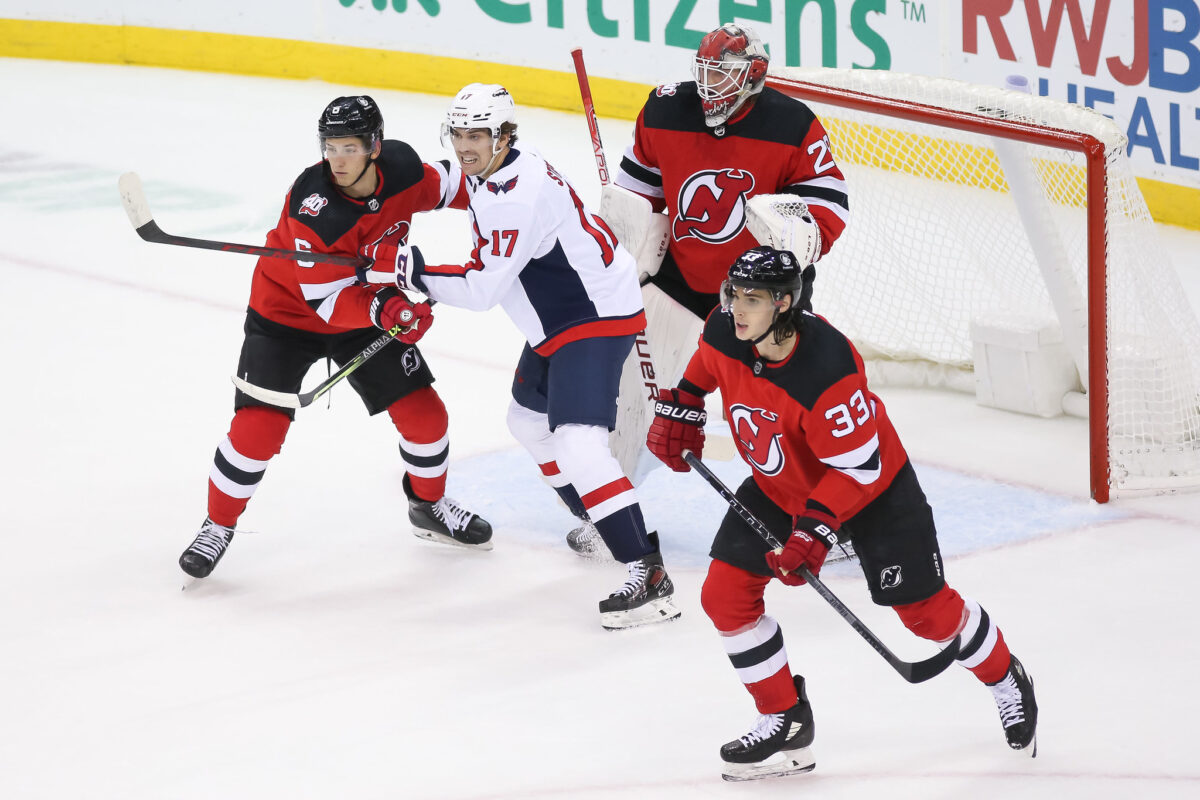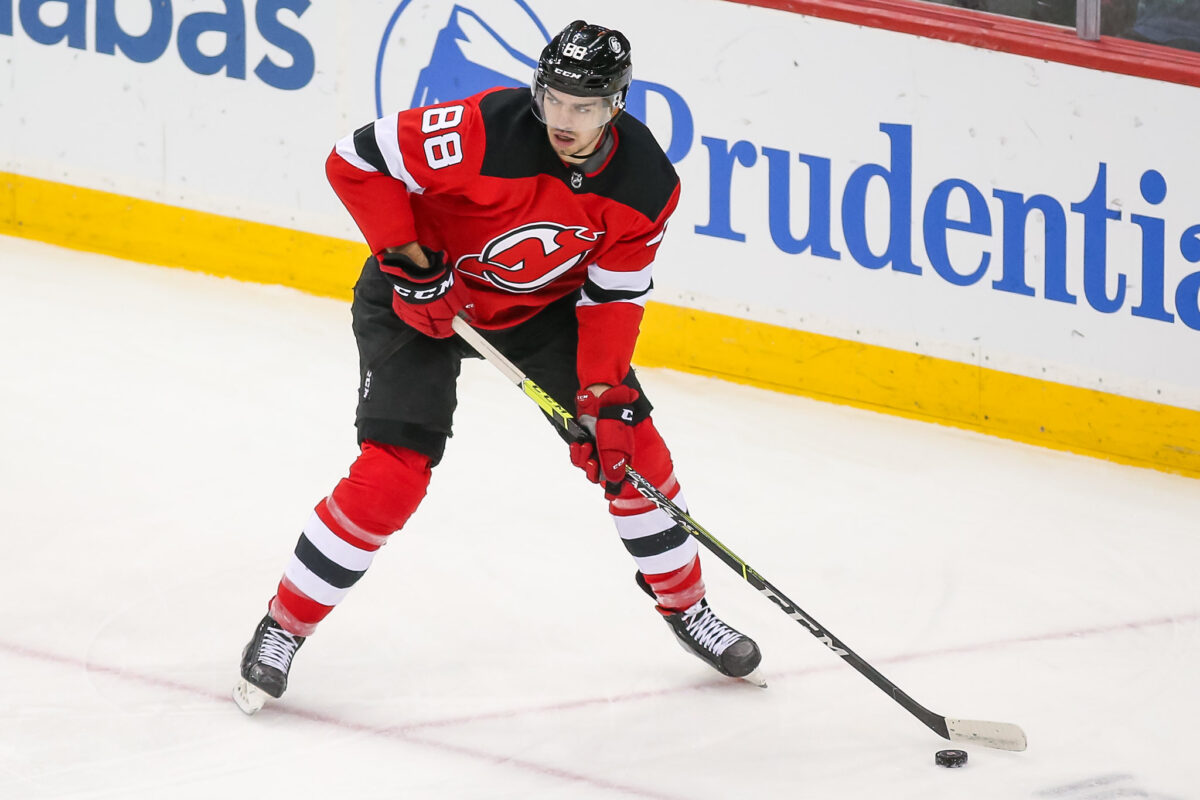When healthy, the New Jersey Devils’ blue line is composed of seasoned professionals with each one having over 200 games of experience. As fans know, injuries occur throughout the 82-game schedule, and from time to time young players will need to step into the lineup. The Devils were overall healthy for the first half of the 2022-23 campaign, but in December, the club lost Ryan Graves for a few games and has been without John Marino since Dec. 21.

A young defenseman who has been with the team for the past few months is 22-year-old Kevin Bahl. He was only sent to the minors once this season on Nov. 22 but days later was recalled on Nov. 28 and has been utilized as the club’s seventh blueliner. The other young defender who has played for New Jersey this season is 22-year-old Nikita Okhotiuk. The former has appeared in 13 games, while the latter has played seven games.
Rookies have a tendency to face heavy scrutiny and Bahl has faced his fair share of criticism from fans these past few weeks. The 6-foot-6 blueliner has struggled of late and eventually, the coaching staff pulled him out of the lineup in favor of Okhotiuk.
After the team’s practice on Jan. 9, I talked with Bahl about the jump from the American Hockey League (AHL) to the NHL and learned what the biggest challenge is for a young defenseman.
The Most Challenging Part of the Transition From AHL to NHL
For a young defenseman, the biggest difference between the two leagues is the pace of play and how much quicker they need to read situations within the game.
“Guys are definitely thinking and knowing what play they’re going to make next,” explained Bahl. “They get the puck and they already know where it’s going, and that’s the biggest difference. You try to have your stick in the lane of where you think he’s going to make that play.”

Having good anticipation is key for every defenseman in the league. For most players getting accustomed to the pace of the NHL, it is learned through trial and error. NHL players are thinking at a higher level and guys know where to be on the ice. It requires opposing blueliners to know where the puck is going, not necessarily where it is at the moment.
Related: Devils’ Kevin Bahl Needs More Playing Time
“It’s reading the situations that are developing a bit quicker,” continued Bahl. “It’s not necessarily that he is going to get to the net quicker, but he is going to know that for this play the puck is supposed to go to the point, and he’s already going to the net knowing that. So it’s kind of everything that is happening. They’re thinking [through plays] quicker.”
On Dec. 28, the Devils hosted the Boston Bruins and fell by a final score of 3-1. Forward Trent Frederic got the scoring started for the Bruins after a giveaway by Michael McLeod, which was collected by Hampus Lindholm. Bahl was not initially anticipating the pass to Frederic and because he was preparing to block a potential shot from Lindholm, Frederic had a clear shot to the net. It was misread by Bahl who tried to recover, but the puck was already on its way to the goal.
If a defenseman is slow to read the play, they are more likely to take a penalty, give the puck away, and be out of position. It’s a trickle-down effect that fans have and will continually see with developing players. So, the question is how does a player go about improving his reads?
Practice Makes Perfect and Patience Is a Virtue
Okhotiuk was recalled from the Utica Comets on Dec. 22 and when he met with reporters, he said that compared to playing in the NHL, the AHL can sometimes be a bit messy. The AHL is a developmental league and that is the coaching staff’s main focus. Overall, there is a lack of structure and speed in the minors, which leads one to wonder if there are certain skills that eventually can’t be developed in the AHL.
When it comes to adjusting to the pace of the NHL, it is something that can only be learned by playing games at the NHL level. Repetition is key for development and the more games played the quicker things will begin to slow down for a player. Of course, there are always steps a player can take to improve regardless of what league they are playing in. There will always be an emphasis on their skating and focus on making plays under pressure. As a defenseman, it’s about becoming the guy who drives and dictates the play.

There are a select few who can immediately adapt to the NHL, but for a lot of players, it takes more time and games to become comfortable with their own game. Not every single defenseman is a Cale Makar, and patience is a virtue when it comes to developing young talent. Rookie players will make rookie mistakes and that is part of the journey. Eventually, the coaching staff can make the decision to pull a defenseman out of the lineup to have them watch the game from above.
Is There a Benefit to Watching the Game From the Suite?
Even though it can be controversial amongst fans, it can actually be beneficial for a young defender to take in a game up in the suite. It allows him to see the play develop and watch the positioning of the veteran blueliners and how they anticipate the play. At the end of the day, it is about having the right attitude and seeing everything as an opportunity.
“I think there’s a lot to learn. If you’re in or you’re out there’s always an opportunity to learn,” said Bahl. “Watching the last game (versus the Rangers) there were a couple of things I picked up on, and I know I can be better. It’s getting an opportunity to learn.”
Bahl and Okhotiuk will continue to learn and look to find consistency in their game as the season progresses. John Marino remains on injured reserve but has been practicing with the team in a non-contact jersey, and eventually, one of the aforementioned defensemen will be reassigned to the Utica Comets to continue to hone their skills under head coach Kevin Dineen. Bahl has been serving as a healthy scratch for the team’s past four games, which happen to all be victories. He will look for an opportunity to jump back into the lineup before Marino returns and joins the team’s veteran blue line.